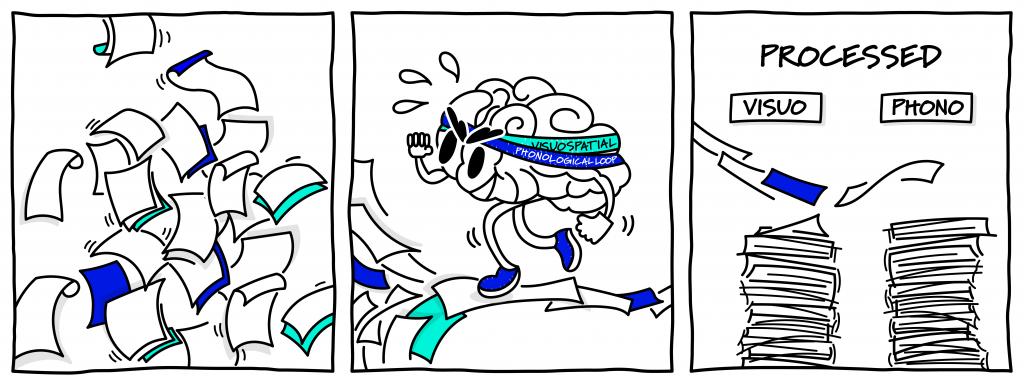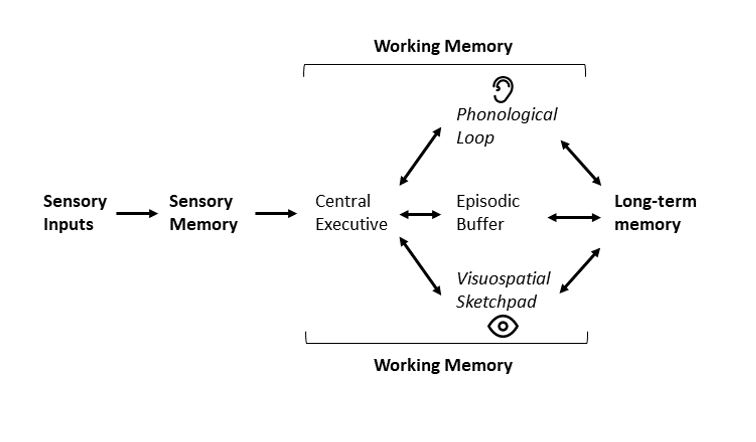2. The science of visuals

If you are new to developing visuals, the creation of a visual will likely take you longer than presenting the same information in a text-based format. In this chapter we present a case for utilising visuals based on cognitive psychology. Hopefully, this encourages you to persist in taking the time to build your skills in creating visuals. The chapter also briefly reviews the archaeological and cultural aspects of visuals to highlight that the creation and interpretation of visuals cannot be separated from the cultural context in which they are used.
2.1 The limited working memory
The reason for using visuals becomes clearer when we understand the architecture of working memory. This section does not provide a comprehensive exploration of working memory (for more information on this, refer to the recommended readings at the end of this chapter), but simply explores how two slave systems within working memory – the phonological loop and visuospatial sketchpad – help explain the beneficial effect of visuals. Further, the concept of cognitive load is introduced and linked to the architecture of the working memory. Through appreciating the issue of limited working memory, the architecture of the working memory, and cognitive load you are better informed to make strategic choices in how you communicate with your stakeholders. These concepts are drawn from both cognitive psychology and instructional design – the design of educational materials.
2.1. Concept exploration: working memory under load
In 2013, Dr Peter Doolittle used the following exercise to help his TED audience discover the working memory and how it can be maximised.
In summary, first Dr Doolittle asked his audience to remember five words – no writing them down! Then, while remembering the five words, he asked them to undertake a series of tasks that put pressure on the working memory: performing a mathematical calculation and listing the five last letters of the alphabet (backwards)!
Note: As you read further in this chapter you will see that this dual-task exercise is the foundation for many experiments exploring working memory.
Commonly, those who can remember the five words and actually perform the two tasks have maximised their working memory by visualising the five words as an image. This image is held in the visuospatial sketchpad while the other tasks are performed in the phonological loop.
2.2 The architecture of working memory
Working memory is defined by Baddeley et al. (2020) as ‘a limited capacity system for the temporary maintenance and processing of information in the support of cognition and action’. The functioning of the working memory remains debated and is acknowledged to be continually evolving. However, the model presented here is that proposed by Baddeley and Hitch, which has broad acceptance and has significant influence in this field (Baddeley et al., 2020). Baddeley and Hitch’s model conceptualises working memory as an interface between sensory input and long-term memory (refer to Figure 3.1). The working memory holds information that enables a range of cognitive tasks to be performed. The working memory also transfers information into and from the long-term memory. Important to the argument for using visuals in project communications, working memory is limited (Chen & Kalyuga, 2020).

Components of the working memory include the central executive, phonological loop, and visuospatial sketchpad (Baddeley, 2006). The central executive has limited capacity, is termed as an attentional control system and fulfils a coordinating function for the phonological loop and visuospatial sketchpad (Baddeley, 2006; Baddeley et al., 2020). The loop and sketchpad are sometimes labelled as subsidiary slave systems (Baddeley, 2006). The phonological loop holds and rehearses auditory and speech-based information (Baddeley, 2006). Visual information is stored in the visuospatial sketchpad (Baddeley, 2006). Both these slave systems have storage limits and capacity is not transferred across the systems. The episodic buffer is a fourth component of working memory but is less understood (Baddeley, 2006). The cognitive benefits of using visuals are attributed to the two distinct slave systems, and the fact that their capacities are not transferred.
Baddeley and Hitch’s working memory arguably aligns with Paivio’s dual coding theory (Thomas, 2021). According to the dual coding theory, visual information is more easily remembered than non-visual information in sequential memory tasks (Paivio, 1971). To elaborate using Paivio’s early experiments, if a series of words are presented to a person in rapid succession, and then a series of images – without time for the person to ‘name’ the image – the sequence of words are remembered better than the sequence of images (Paivio & Csapo, 1969). However, when presented at such a pace that the person can ‘name’ the images, their recall of the sequence of images is approximately equal in accuracy to their recall of the sequence of words (Paivio & Csapo, 1971). It is important to highlight that these early experiments were focused on assessing capacity for storing sequential information. Paivio and Csapa’s (1971) experiments also establish differences in recall depending on whether words refer to concrete objects or abstract concepts. This distinction is relevant to visualisation in project management where concepts being communicated are often abstract. Dual coding theory would espouse that the more ‘concrete’ the communication, the more likely the message is remembered.
Similar to Baddeley and Hitch’s working memory architecture, and helping explain the naming of their theory, according to Clark and Paivio (1991), the human mind has two types of codes (representations): verbal and imagery. According to dual coding theory, retention and retrieval is enhanced when both a verbal and imagery representation is created. That is, the memory is stored in two systems rather than just one. Paivio’s theory is associated with the ‘pictorial superiority effect’ (Yang et al., 2017) and recent studies continue to find that when both images and text are utilised there is an increase in reader engagement (Yang et al., 2017). It is important to caution that while dual coding theory has influenced numerous aspects of psychology research, it is not without controversy, with counter perspectives including the ‘propositional’ theory and the ‘common coding theory’.
2.3 Working memory and cognitive load
Cognitive load – more simply stated as ‘mental effort’ – is linked to depleted working memory (Chen & Kalyuga, 2020; Clark et al., 2006). Cognitive load theory has connections to the concept of the magical number of 7+/- 2 (see Concept Exploration 2.2) and is associated with John Sweller (Clark et al., 2006). When communicating, it is beneficial to decrease wasteful cognitive load and maximise the capacity of project stakeholders’ working memory architecture. As demonstrated in Peter Doolittle’s activity (see Concept exploration 2.1), a key mechanism for achieving this is through utilising the capacity in both the visuospatial sketchpad and the phonological loop (Clark et al., 2006). The benefits of utilising both systems is established in various studies. For example, if a person is asked to perform a primary task which utilises the phonological loop, and then a secondary task which also utilises the phonological loop, performance is compromised (Clark et al., 2006). However, if the primary task utilises the phonological loop and secondary task utilises the visuospatial sketchpad there is minimal adverse performance impact (Clark et al., 2006).
Concept exploration 2.2: limits and potential of working memory
In this short video [approx. 11 mins], Professor of Cognitive Neuroscience, Torkel Klingberg describes the limits of, but also potential to train the working memory. He briefly introduces the tendency to remember 7+/-2 elements, but importantly reveals that game-like exercises are being developed to maximise working memory.
Cognitive load theory identifies multiple types of load. It is intrinsic load that is most relevant to the use of visuals. Intrinsic load is associated with the processing that needs to occur to achieve the communication goal (Chen & Kalyuga, 2020). However, through the use of visuals along with supporting auditory or textual information it is possible to manage this intrinsic load to maximise stakeholders’ limited working memory. Extraneous load is associated with a processing burden that is superfluous to the communication goal (Chen & Kalyuga, 2020). Ideally, the choices made in the design of the visual should minimise extraneous load. Plainly stated, this reminds the project manager not to include information in their visual that does not support the message being communicated or the stakeholders’ information needs.
2.4 Applied efficacy for the use of visuals
Chapter 3 explores the use of visuals in project management. However, professions beyond project management are also currently increasing the rate at which visuals are used to enhance performance. For example, in the medical profession, an experiment was undertaken with doctors which compared recall of patient data when it included pictorial and textual information compared to the use of no visuals (Wolch et al., 2017). It is normal for recall of patient data to fall over time. However, this decline was less for the doctors who viewed records with pictorial data. Visual management (VM) is a frequently discussed concept in production management research (Tezel et al., 2016), with foundations in the Toyota Production System (TPS) (Koskela et al., 2018). A component of VM is the use of sensory work aids – often visual in nature – to support the production process and continuous improvement. According to Tezel et al. (2016), VM can support transparency, discipline, continuous improvement, job facilitation, on-the-job training, creating shared ownership, management by facts, simplification and unification.
2.5 A historical and cultural perspective
In this chapter the discussion so far has been dominated by a cognitive psychology perspective of visuals with little reference to the archaeology or cultural aspects of visuals. Briefly, we digress to somewhat address this imbalance. The architecture of working memory that we have described, and facts such as sight being dependent on light and the anatomy of our eyes, are important to our understanding of how visuals work and inform how we develop and use visuals (Janik & Kaner, 2018). However, the way we create and interpret visuals is reflective of our life histories and cultures (Janik & Kaner, 2018). When designing visuals this is an important acknowledgement and necessitates an appreciation of the potential interpretations stakeholders will bring to the visual. As will be discussed in Chapter 5, the meaning of colours is not universal: colours can have different meanings for people in different cultures (Aslam, 2006). For example, in Anglo-Saxon and Nordic cultures blue is interpreted as masculine, whereas it is associated with femininity in Germanic cultures. Red is associated with love or happiness in China, but fear, anger and jealousy in Slavic cultures (Aslam, 2006). The language of different nationalities also impacts how colour is classified. In some languages, for example Dani and Bassa, there are only two terms for colour: dark and light (Casaponsa & Athanasopoulos, 2018).
The use of visuals is also linked to broader societal developments such as available tools and technologies. In earlier eras, pictograms and ideograms, such as those associated with the Egyptians, fulfilled a significant role in storytelling (Dewan, 2015). The nature and use of such illustrations was linked to available resources to create these visuals. For example, it is suggested that the colour blue was not used by prehistoric artists because this pigment was not easily available (Janik & Kaner, 2018). In today’s society it is the increasing availability of sophisticated software and screens that have advanced the use of visuals in diverse domains (Dewan, 2015). Latour (1986) associates visuals with our increasingly knowledge-based occupations. He argues that it is through what he terms ‘inscriptions’ that the competition of ideas plays out, and that visuals are a particularly effective form of inscription in this race and become sources of power in our societies. The ability of inscriptions to be mobile – spread/shared between people – scalable and reproducible among other features are central to their power (Latour, 1986). To summarise, when developing visuals and considering their use, we cannot separate them from the micro and macro cultural contexts in which they are used.
2.6 Maximising working memory for project stakeholders
Let’s return to our primary focus of this chapter – the cognitive psychology of visuals – and apply the architecture of working memory to the project management context. Frequently, a project manager will need to engage with senior executives or managers who are not familiar with the day-to-day aspects of a project but need to provide approvals or make strategic decisions related to the initiative. In such situations, the project manager will often prepare some form of documentation followed by a verbal briefing in a meeting or phone call. For demonstration purposes, let’s explore an example where the project manager’s ultimate goal is to derive a decision on a supplier to fulfil a critical project requirement. Let’s imagine that we could use two different communication approaches to this situation (refer to Table 2.1).
Approach 1:
The project manager could prepare a memorandum with no visuals that discusses the advantages and disadvantages of the multiple suppliers that are under consideration in a text-only format. There may be an expectation that the senior executive has read this in advance of the meeting and the project manager provides a recap in the meeting while pointing to various sections in the memorandum. At the end of the conversation, the project manager hopes the executive will provide a decision on the preferred supplier.
In this approach both the memorandum and conversation are placing load on the phonological loop, and not taking advantage of the visuospatial sketchpad. The working memory is not maximised.
Approach 2:
By contrast, the project manager could prepare a document that presents the comparison of the advantages and disadvantages of the multiple suppliers in a tabular format that makes identification of the recommended supplier more obvious. Certainly, there may be textual narration to summarise the table and an accompanying discussion, but this approach uses both the phonological loop and the visuospatial sketchpad to maximise working memory. Both systems within the working memory are being utilised.

Now let’s link these two approaches to cognitive load theory. The project manager’s communication goal is to enable a decision on a preferred supplier. The intrinsic load for the executive is associated with making this determination. Through using the table in Approach 2, the executive’s working memory is maximised and therefore the intrinsic load is reduced. In Approach 1, there is potential that the executive tries to create some form of table in his mind’s eye (or on paper) to leverage the visuospatial sketchpad, but this is (unnecessarily) increasing the intrinsic load of the task. If the memorandum (or table, or discussion) included information superfluous to the decision at hand, this would be creating extraneous load. And should be avoided.
As is prevalent in psychological theorising, the models and theories presented here continue to be explored and tested, have limits and critiques. Nevertheless, they are presented here as an example of the current arguments for the benefits in utilising visuals.
Chapter 2 summary
- Working memory, which is essential for problem solving and decision-making is limited
- Working memory includes two slave systems: the visuospatial sketchpad (which holds visual information) and the phonological loop (which holds auditory and textual information)
- Cognitive load can be reduced by leveraging the limited capacity of both the visuospatial sketchpad and phonological loop
- The use, development and interpretation of visuals should take into account the cultural contexts in which they are used
- Project managers, through the strategic use of cognitive psychology insights and cultural norms, can enhance their communication
Recommended readings
On the architecture of working memory
- Baddeley, A., Hitch, G., & Allen, R. (2020). A multicomponent model of working memory. In R. Logie, V. Camos, & N. Cowan (Eds.), Working memory: The state of the science. Oxford University Press. https://doi.org/10.1093/oso/9780198842286.003.0002
- Klingberg, T. (2009). The overflowing brain information overload and the limits of working memory. Oxford University Press. [Ch. 3 – 6].
Designing communication to reduce cognitive load
- Clark, R. C., Nguyen, F., & Sweller, J. (2006). Efficiency in learning evidence-based guidelines to manage cognitive load. Pfeiffer. [Ch. 3].
Archaeology and cultural aspects of visuals
- Aslam, M. M. (2006). Are you selling the right colour? A cross‐cultural review of colour as a marketing cue. Journal of Marketing Communications, 12(1). 15-30. https://doi.org/10.1080/13527260500247827 [Table 1].
Media attributions
Figure 2.1: Adapted from Baddeley Working Memory Model by Laura Dahl licensed under CC-BY-NC licence, and originally inspired by Baddley and Hitch’s works on working memory. This diagram has been created using an ear icon by iconsminds and an eye icon by Nguyen Van Sao, which are both licensed under CC-BY licence.
Cartoon: designed by Samara Hoffmann licensed under a CC-BY-NC-SA licence.

